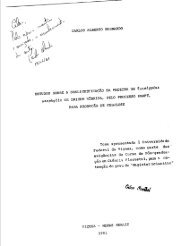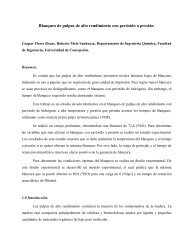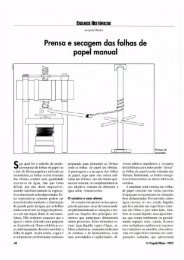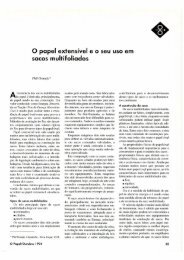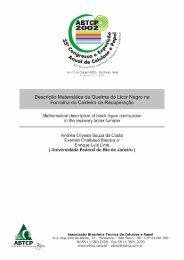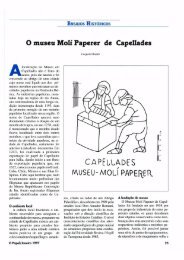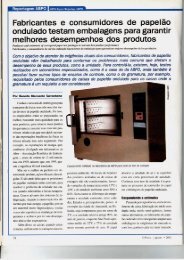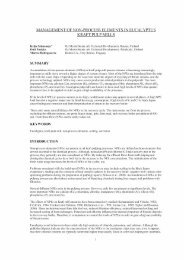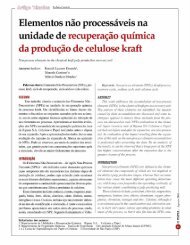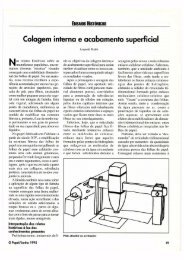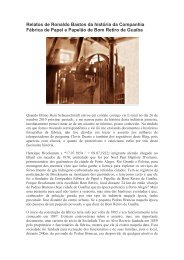O Eucalipto: um século no Brasil (The Eucalypt - Celso Foelkel
O Eucalipto: um século no Brasil (The Eucalypt - Celso Foelkel
O Eucalipto: um século no Brasil (The Eucalypt - Celso Foelkel
You also want an ePaper? Increase the reach of your titles
YUMPU automatically turns print PDFs into web optimized ePapers that Google loves.
Escolha das espécies<br />
Choice of species<br />
Como muitos gêneros vegetais, a escolha da espécie a plantar procura associar sua<br />
adaptabilidade ao local refletida <strong>no</strong> crescimento, resistência a pragas, doenças e condições<br />
climáticas e edáficas adversas, qualidade da madeira e conseqüente desti<strong>no</strong> final<br />
na mesma e outros produtos não-madeireiros. Poucas são as espécies comerciais que se<br />
enquadram dentro desses critérios, destacando-se entre elas o ‘E. saligna’, o ‘E. grandis’,<br />
o ‘E. urophilla’, e seus híbridos, o (‘E. ‘urograndis’), o ‘E. viminalis’, o ‘E. dunnii’, o ‘E.<br />
camaldulensis’, o ‘E. cloeziana’, o ‘E. citriodora’, entre outros.<br />
No início da eucaliptocultura comercial <strong>no</strong> <strong>Brasil</strong> a preocupação básica foi com a qualidade das<br />
sementes, do que resultou <strong>um</strong> intenso e diversificado programa de melhoramento florestal.<br />
O passo seguinte foi a seleção de clones e seus empregos na propagação vegetativa, explica o professor<br />
Poggiani. “Começamos a reproduzir clones a partir de estacas”, tomando-se por exemplo<br />
os brotos que surgiam do cepo cortado de <strong>um</strong>a árvore de grande crescimento, para plantá-los<br />
com hormônio que induza o surgimento de raízes. “O resultado, é que reproduzimos árvores<br />
idênticas geneticamente à árvore-mãe, fazemos na realidade réplicas da mesma”.<br />
O E U C A L I P T O - U M S É C U L O N O B R A S I L<br />
78<br />
Preparação de estacas para plantio.<br />
Preparation of stakes for planting.<br />
As many forest genus, the choice of species to plant seeks to associate their adaptability<br />
to the location, as reflected in their growth, resistance to pests, diseases and weather conditions<br />
and to adverse soils, wood quality and, thus, the final destination in it and other<br />
<strong>no</strong>n-wood products. <strong>The</strong>re are few commercial species that fit into these criteria, among<br />
which ‘E. saligna’, ‘E. grandis’, ‘E. urophilla’, and hybrids,( ‘E. urograndis’), E. viminalis,<br />
‘E. dunnii’, ‘E. camaldulensis’, ‘E. cloeziana’, and ‘E. citriodora’, among others.<br />
In the onset of commercial eucalypt plantations in Brazil, the basic concern was with genetic<br />
seed quality, from which an intense, diversified forest improvement program resulted.<br />
<strong>The</strong> next step was clone selecting and using them in vegetation propagation, explained<br />
professor Poggiani. “We started reproducing clones from rooted cuttings,” using, for<br />
example, the sprouts that came out of a stub cut off a tree with major growth, to plant<br />
them with root-inducing hormones. “<strong>The</strong> outcome of that was that we reproduce trees<br />
that are genetically identical to the mother tree. In fact, we made replicas of it.”<br />
Research, crucial in the case of eucalypt, advanced with tissue culture and, as a result,<br />
Brazilian eucalypts planting started counting on high quality trees, with increasingly better<br />
wood to produce pulp, charcoal, plates, or even trees with less wood growth tension, facilita-





